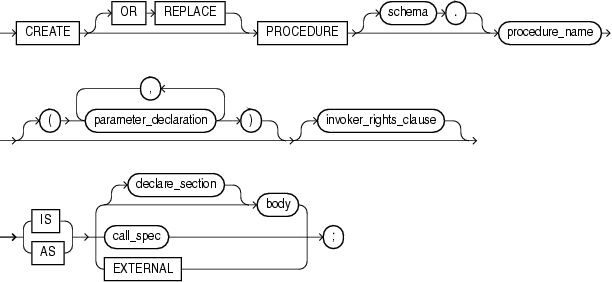| Oracle® Database PL/SQL Language Reference 11g Release 2 (11.2) Part Number E10472-05 |
|
|
View PDF |
| Oracle® Database PL/SQL Language Reference 11g Release 2 (11.2) Part Number E10472-05 |
|
|
View PDF |
The CREATE PROCEDURE statement creates or replaces a standalone stored procedure or a call specification.
A standalone stored procedure is a procedure (a subprogram that performs a specific action) that is stored in the database.
Note:
A standalone stored procedure that you create with theCREATE PROCEDURE statement differs from a procedure that you declare and define in a PL/SQL block or package. For information about the latter, see "Procedure".A call specification declares a Java method or a third-generation language (3GL) subprogram so that it can be called from PL/SQL. You can also use the SQL CALL statement to call such a method or subprogram. The call specification tells the database which Java method, or which named procedure in which shared library, to invoke when a call is made. It also tells the database what type conversions to make for the arguments and return value.
Topics:
Prerequisites
To create or replace a standalone stored procedure in your own schema, you must have the CREATE PROCEDURE system privilege. To create or replace a standalone stored procedure in another user's schema, you must have the CREATE ANY PROCEDURE system privilege.
To invoke a call specification, you may need additional privileges, for example, the EXECUTE object privilege on the C library for a C call specification.
To embed a CREATE PROCEDURE statement inside an Oracle precompiler program, you must terminate the statement with the keyword END-EXEC followed by the embedded SQL statement terminator for the specific language.
See Also:
For more information about such prerequisites:Syntax
create_procedure ::=

See:

call_spec ::=

Java_declaration ::=
C_declaration ::=

Semantics
OR REPLACE
Re-creates the procedure if it exists, and recompiles it.
Users who were granted privileges on the procedure before it was redefined can still access the procedure without being regranted the privileges.
If any function-based indexes depend on the procedure, then the database marks the indexes DISABLED.
schema
The name of the schema containing the procedure. The default is your own schema.
procedure_name
The name of the procedure to be created.
invoker_rights_clause
Specifies the AUTHID property of the procedure. For information about the AUTHID property, see "Invoker's Rights and Definer's Rights (AUTHID Property)".
body
The required executable part of the procedure and, optionally, the exception-handling part of the procedure.
declare_section
The optional declarative part of the procedure. Declarations are local to the procedure, can be referenced in body, and cease to exist when the procedure completes execution.
call_spec
Maps a Java or C method name, parameter types, and return type to their SQL counterparts.
In the Java_declaration, string identifies the Java implementation of the method.
See Also:
Oracle Database Java Developer's Guide for an explanation of the parameters and semantics of the Java_declaration
Oracle Database Advanced Application Developer's Guide for information about calling external procedures
EXTERNAL
The EXTERNAL clause is an alternative way of declaring a C method. In most cases, Oracle recommends that you use the LANGUAGE C syntax. However, EXTERNAL is required if a default argument is used as a parameter or if a parameter uses a PL/SQL data type that must be mapped (for example, Boolean). EXTERNAL causes the PL/SQL layer to be loaded so that the parameters can be properly evaluated.
Examples
Creating a Procedure: Example This statement creates the procedure remove_emp in the schema hr.
CREATE PROCEDURE remove_emp (employee_id NUMBER) AS
tot_emps NUMBER;
BEGIN
DELETE FROM employees
WHERE employees.employee_id = remove_emp.employee_id;
tot_emps := tot_emps - 1;
END;
/
The remove_emp procedure removes a specified employee. When you call the procedure, you must specify the employee_id of the employee to be removed.
The procedure uses a DELETE statement to remove from the employees table the row of employee_id.
See Also:
"Creating a Package Body: Example" to see how to incorporate this procedure into a packageIn this example, external procedure c_find_root expects a pointer as a parameter. Procedure find_root passes the parameter by reference using the BY REFERENCE phrase.
CREATE PROCEDURE find_root
( x IN REAL )
IS LANGUAGE C
NAME c_find_root
LIBRARY c_utils
PARAMETERS ( x BY REFERENCE );
Related Topics
In this chapter:
In other chapters:
See Also:
Oracle Database SQL Language Reference for information about the CALL statement)
Oracle Database Advanced Application Developer's Guide for more information about call specifications